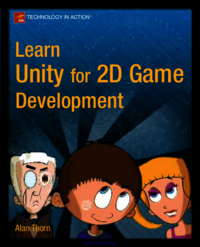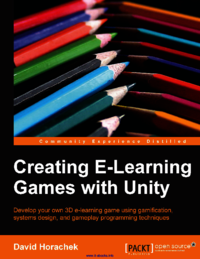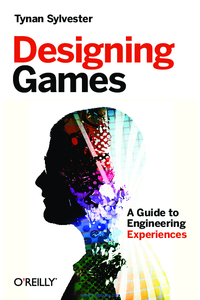Usuario "fcastellanos"
Se han encontrado 6 Coincidencias
Learn Unity for 2D Game Development
Desarrollo de juegos 2D en Unity
101 Visitas | 373 Descargas | 2018-11-23 20:11:31 | fcastellanos
If you log on to any online or mobile marketplace for games and browse the titles offered today, it’s likely that the majority of games you see will be 2D and not 3D. If you think back over the relatively short history of video games, or if you listen to industry veterans talking about their inspirations and favorite games, it’s likely that the titles most mentioned are in the 2D style. Frequently listed titles in these video game reminiscences include: Pacman, Sonic the Hedgehog, Super Mario Brothers, Tetris, Lemmings, Arkanoid, Bejewelled, Angry Birds, Plants vs Zombies, Minesweeper, Civilization, Donkey Kong, and Sim City. Despite the manifold differences between all these landmark games both new and old, they all share the common ingredient of 2D-ness; of having their graphics presented in a very specific way that doesn’t rely on three-dimensional space. In short, the 2D style represents some of the most well-known titles in video games history, and it is also a style that is alive and well today. 2D games are not simply stuck in history. They are not a thing of the past; a phenomena that has been and is no longer relevant to the demands of contemporary gamers. Rather, these games represent a significant and lucrative segment of the video game market. Often has been the occasion when this or that learned person has predicted the demise of 2D games, and yet despite all such predictions 2D games have not gone away. This resilience and strength is due primarily to their general popularity, charm, and stylistic simplicity. 2D imparts a classical and timeless feel to games that is technically difficult to replicate by alternative means. For this reason, gamers keep coming back to the 2D style and find within it new ways of enjoying games and experiencing richness. 2D games today play an especially prominent role in two large market areas, and for different reasons. These markets are the casual game market and the so-called “indie games market.” In the casual games market, including games such as Mystery Case Files and Bejewelled, the 2D style is deployed to add an accessible “pick up and play” feel that does not require the user to learn any complex control systems or to concern themselves with moving a camera in 3D space. The Indie Games market, including games such as Retro City Rampage and Super Meat Boy, have used the 2D style to create a retro or old school feel that is popular to a general audience.

Building a Game with Unity and Blender
Desarrollo de videojuegos en Unity y Blender
110 Visitas | 315 Descargas | 2018-11-23 20:13:34 | fcastellanos
In the wake of the indie game development scene, game development tools are no longer luxury items costing up to millions of dollars but are now affordable by smaller teams or even individual developers. Among these cutting-edge applications, Blender and Unity stand out from the crowd as a powerful combination that allows small to no budget indie developers or hobbyists alike to develop games that they have always dreamt of creating.

Creating E-Learning Games with Unity
E-learning can be described as the use of computers and digital technology to facilitate teaching and learning. One popular method of accomplishing this, and which is also the approach we will take in this book, is through gamification of learning, that is, the application of cognitive psychology and game-based rules to learning systems.
79 Visitas | 462 Descargas | 2018-11-23 20:15:24 | fcastellanos
E-learning can be described as the use of computers and digital technology to facilitate teaching and learning. One popular method of accomplishing this, and which is also the approach we will take in this book, is through gamification of learning, that is, the application of cognitive psychology and game-based rules to learning systems.

Designing Games
How do you design a video game that people love to play? In this practical guide, game designer Tynan Sylvester shows you how to create emotionally charged experiences through the right combination of game mechanics, fictional wrapping, and story. You’ll learn design principles and practices used by top studios, backed by examples from today’s most popular games. This book also takes you through the day-to-day process necessary to keep your project on track: when to build and when to test, how to work with a team, and how to avoid creative dead ends.
100 Visitas | 148 Descargas | 2018-11-23 20:17:16 | fcastellanos
How do you design a video game that people love to play? In this practical guide, game designer Tynan Sylvester shows you how to create emotionally charged experiences through the right combination of game mechanics, fictional wrapping, and story. You’ll learn design principles and practices used by top studios, backed by examples from today’s most popular games. This book also takes you through the day-to-day process necessary to keep your project on track: when to build and when to test, how to work with a team, and how to avoid creative dead ends.

Pixel art for game developers
As a kid, did you ever get right up close to the TV despite your parents’warningsthatitwillmakeyoucross-eyedandturnyoureyes into bloody stumps? If you did, you would have noticed that the images werecreatedwithtinydotsofbrightcolor.Thosetinydotsarecalledpixels. PixelscomposetheimagesthataredisplayedonTVs,computermonitors, tablets,phones,andmostotherdigitaldevices. Computer graphics were originally built by manipulating those dots of color one pixel at a time, which became the early history of Pixel Art. In some cases, those pixels were controlled through cumbersome programmingscriptsbutovertimecomputerartprogramsbecamemorecommon andthequalityofrepresentationimproved. Pixel Art grew out of technical restraints from a generation ago. Game systems had much less memory and worked with much smaller pixel dimensionsthantoday,soitwasatechnicalnecessitytoworkwithintight restraintsonsizeandcolor. As games grew in quality and sophistication, it became important to makethemostoutoftheaestheticswithinthetechnicalrestraints.Outof thisera,some“bestpractices”grewoutoftheprocessandhaveevolvedinto whatwenowthinkofasPixelArt. BeforestartingtorantonthemanyusefulaspectsofPixelArtingames and applications or even explaining what Pixel Art is, I want to give examplesofwhatitisnot. 3D graphics are not Pixel Art (Figure F.1), despite that they are being createdbypixelsonscreen.
53 Visitas | 90 Descargas | 2019-08-28 02:48:10 | fcastellanos
As a kid, did you ever get right up close to the TV despite your parents’warningsthatitwillmakeyoucross-eyedandturnyoureyes into bloody stumps? If you did, you would have noticed that the images werecreatedwithtinydotsofbrightcolor.Thosetinydotsarecalledpixels. PixelscomposetheimagesthataredisplayedonTVs,computermonitors, tablets,phones,andmostotherdigitaldevices. Computer graphics were originally built by manipulating those dots of color one pixel at a time, which became the early history of Pixel Art. In some cases, those pixels were controlled through cumbersome programmingscriptsbutovertimecomputerartprogramsbecamemorecommon andthequalityofrepresentationimproved. Pixel Art grew out of technical restraints from a generation ago. Game systems had much less memory and worked with much smaller pixel dimensionsthantoday,soitwasatechnicalnecessitytoworkwithintight restraintsonsizeandcolor. As games grew in quality and sophistication, it became important to makethemostoutoftheaestheticswithinthetechnicalrestraints.Outof thisera,some“bestpractices”grewoutoftheprocessandhaveevolvedinto whatwenowthinkofasPixelArt. BeforestartingtorantonthemanyusefulaspectsofPixelArtingames and applications or even explaining what Pixel Art is, I want to give examplesofwhatitisnot. 3D graphics are not Pixel Art (Figure F.1), despite that they are being createdbypixelsonscreen.

Documentacion de Godot Engine
65 Visitas | 74 Descargas | 2019-08-29 01:38:48 | fcastellanos
Welcometotheof?cialdocumentationofGodotEngine,thefreeandopensourcecommunity-driven2Dand3Dgame engine! Behind this mouthful, you will ?nd a powerful yet user-friendly tool that you can use to develop any kind of game, for any platform and with no usage restriction whatsoever. This page aims at giving a broad presentation of the engine and of the contents of this documentation, so that you know where to start if you are a beginner or where to look if you need info on a speci?c feature. 1.1.1 About Godot Engine A game engine is a complex tool, and it is therefore dif?cult to present Godot in a few words. Here’s however our PR presentation, which you are free to reuse if you need a quick writeup about Godot Engine. Godot Engine is a feature-packed, cross-platform game engine to create 2D and 3D games from a uni?ed interface. It provides a comprehensive set of common tools, so that users can focus on making games without having to reinvent the wheel. Games can be exported in one click to a number of platforms, including the major desktop platforms (Linux, macOS, Windows) as well as mobile (Android, iOS) and web-based (HTML5) platforms. Godot is completely free and open source under the permissive MIT license. No strings attached, no royalties, nothing. Users’ games are theirs, down to the last line of engine code. Godot’s development is fully independent and community-driven, empowering users to help shape their engine to match their expectations. It is supported by the Software Freedom Conservancy not-for-pro?t.
Contribuir
Usted puede contribuir con Libros UCLV, es importante para nosotros su aporte..
Contribuir